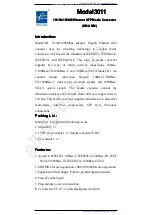
1.Introduction
Terms and Definitions
VSP 737 User Manual 19
display device, the color control adjusts the saturation. Not to be
confused with the brightness, saturation is the amount of pigment in a
color, and not the intensity. Low saturation is like adding white to the
color, for example, a low-saturated red looks pink.
“Scaling”:
It is a conversion of a video or computer graphic signal from
a starting resolution to a new resolution. Scaling from one resolution to
another is typically done to optimize the signal for inputting to an image
processor, transmission path or to improve its quality when presented
on a particular display.
“SDI”:
Serial Digital Interface. The standard is based on a 270 Mbps
transfer rate. This is a 10-bit, scrambled, polarity independent interface
with common scrambling for both component ITU-R 601 and
composite digital video and four channels of (embedded) digital audio.
“Seamless Switching”:
A feature found on many video switchers. This
feature causes the switcher to wait until the vertical interval to switch.
This avoids a glitch (temporary scrambling) which normally is seen
when switching between sources.
“SMPTE”:
Society of Motion Picture and Television Engineers. It is a
global organization, based in the United States, which sets standards
for baseband visual communications. This includes film as well as
video and television standards.
“S-video”:
A composite video signal separated into the luma (―Y‖ is for
luma, or black and white information; brightness) and the chroma (―C‖
is an abbrethroughtion for chroma, or color information).
“Sync”:
Synchronization. In video, sync is a means of controlling the
timing of an event with respect to other events. This is accomplished
with timing pulsing to insure that each step in a process occurs at the
correct time. For example, horizontal sync determines exactly when to
begin each horizontal scan line. Vertical sync determines when the
image is to be refreshed to start a new field or frame. There are many
other types of sync in video system.
(Also known as ―sync signal‖ or
―sync pulse.‖)
“TCP/IP”:
Transmission Control Protocol/Internet Protocol. The
communication protocol of the Internet. Computers and devices with
direct access to the Internet are provided with a copy of the TCP/IP
program to allow them to send and receive information in an
understandable form.
“USB”:
Universal Serial Bus. USB was developed by seven PC and
telecom industry leaders (Compaq, DEC, IBM, Intel, Microsoft, NEC,
and Northern Telecom). The goal is easy plug-and-play expansion
outside the box, requiring no additional circuit cards. Up to 127
external computer devices may be added through a USB hub, which
may be conveniently located in a keyboard or monitor. USB devices
Содержание VSP 737
Страница 1: ...VSP 737 User Manual 1 VSP 737 User Manual Manual RGB RD UM V737 E001 Revision V1 0...
Страница 12: ...VSP 737 User Manual 12 Upgrade of Communication Firmware 84...
Страница 45: ...4 Menu Orientation WIPE VSP 737 User Manual 45...
Страница 47: ...4 Menu Orientation MENU VSP 737 User Manual 47...
















































